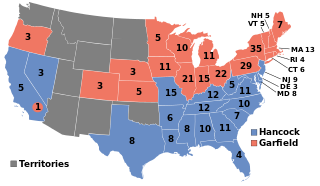
The 1880 United States presidential election was the 24th quadrennial presidential election, held on Tuesday, November 2, 1880, in which Republican nominee James A. Garfield defeated Winfield Scott Hancock of the Democratic Party. The voter turnout rate was one of the highest in the nation's history. Garfield was assassinated during his first year in office, and he was succeeded by his vice president, Chester A. Arthur.
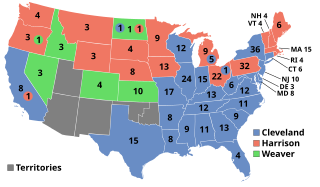
The 1892 United States presidential election was the 27th quadrennial presidential election, held on Tuesday, November 8, 1892. In the fourth rematch in American history, the Democratic nominee, former president Grover Cleveland, defeated the Republican incumbent, President Benjamin Harrison. Cleveland's victory made him the first president in American history to be elected to a non-consecutive second term, a feat that would not be repeated until Donald Trump was elected again in 2024. This was the first of two occasions when incumbents were defeated in consecutive elections—the second being Gerald Ford's loss in 1976 to Jimmy Carter followed by Carter's loss in 1980 to Ronald Reagan.

Bloomfield is a city in Davis County, Iowa, United States. The population was 2,682 at the 2020 census. It is the county seat of Davis County.
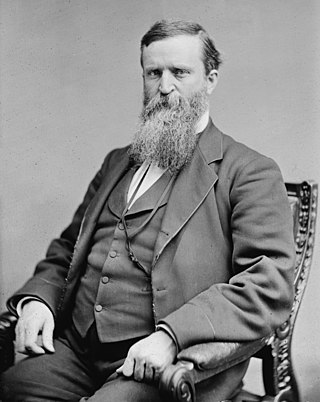
James Baird Weaver was an American politician in Iowa who was a member of the United States House of Representatives and two-time candidate for President of the United States.

The People's Party, usually known as the Populist Party or simply the Populists, was an agrarian populist political party in the United States in the late 19th century. The Populist Party emerged in the early 1890s as an important force in the Southern and Western United States, but declined rapidly after the 1896 United States presidential election in which most of its natural constituency was absorbed by the Bryan wing of the Democratic Party. A rump faction of the party continued to operate into the first decade of the 20th century, but never matched the popularity of the party in the early 1890s.
The Greenback Party was an American political party with an anti-monopoly ideology which was active from 1874 to 1889. The party ran candidates in three presidential elections, in 1876, 1880 and 1884, before it faded away.

Lyndhurst, also known as the Jay Gould estate, is a Gothic Revival country house that sits in its own 67-acre (27 ha) park beside the Hudson River in Tarrytown, New York, about a half mile south of the Tappan Zee Bridge on US 9. The house was designated a National Historic Landmark in 1966.
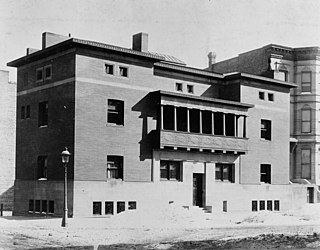
The James Charnley Residence, also known as the Charnley-Persky House, is a historic house museum at 1365 North Astor Street in the near northside Gold Coast neighborhood of Chicago, Illinois. Designed in 1891 and completed in 1892, it is one of the few surviving residential works of Adler & Sullivan.

Edward Hooker Gillette was a nineteenth-century populist politician and editor from Iowa. He was elected on the Greenback Party ticket to represent Iowa's 7th congressional district for only one term in Congress, but remained active in populist political movements. Gillette was the son of Senator Francis Gillette and Elisabeth Daggett Hooker, a descendant of Rev. Thomas Hooker, and the brother of actor/playwright William Gillette.
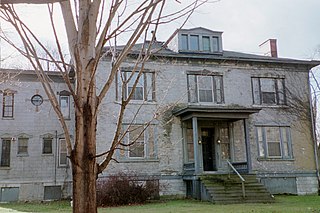
The Roscoe Conkling House is a historic house at 3 Rutger Park in Utica, New York, United States. A National Historic Landmark, it was the home of Roscoe Conkling (1829–1888), a powerful and controversial politician. He is responsible, perhaps, for the angry, political atmosphere that led to the assassination of U.S. President James Garfield.

The William P. Hepburn House is a historic house and National Historic Landmark in Clarinda, Iowa. It was home to United States Congressman William P. Hepburn (1833–1916) from about 1867 until his death. Hepburn most significantly introduced the Hepburn Act of 1906, which gave the Federal government the power to set railroad rates, and was an important precedent in Federal regulation of private industry. The house was declared a National Historic Landmark in 1976. It is a private residence, not generally open to the public.

The Farm House, also known as the Knapp–Wilson House, is the oldest building on the campus of Iowa State University in Ames, Iowa. Now a museum open to the general public, this house was built 1861-65 as part of the model farm that eventually became Iowa State. It was designated a National Historic Landmark in 1964 for its association with agriculturist and teacher Seaman A. Knapp and with U.S. Secretary of Agriculture James Wilson, both of whom lived here while teaching at Iowa State.
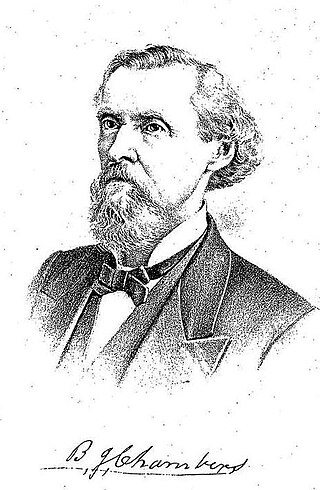
Barzillai Jefferson Chambers was an American surveyor, lawyer, and politician of the Gilded Age. Born in Kentucky, he moved to Texas to join its war for independence against Mexico. Chambers stayed in Texas after its independence and annexation by the United States, earning a living as a surveyor and farmer in Johnson County. In the American Civil War, he served briefly in the Confederate army, then returned to his farming and business interests, becoming part-owner of a bank in his hometown of Cleburne.

The 1892 United States presidential election in California was held on November 8, 1892, as part of the 1892 United States presidential election. State voters chose nine representatives, or electors, to the Electoral College, who voted for president and vice president.

The Old City Hall, also known as Oxford Flats, is located just north of downtown along a commercial corridor in Davenport, Iowa, United States. It was individually listed on the National Register of Historic Places in 1983. In 2020 it was included as a contributing property in the Davenport Downtown Commercial Historic District.

The 1880 Greenback Party National Convention convened in Chicago from June 9 to June 11 to select presidential and vice presidential nominees and write a party platform for the Greenback Party in the United States presidential election 1880. Delegates chose James B. Weaver of Iowa for President and Barzillai J. Chambers of Texas for Vice President.

The Brown Street Historic District is a nationally recognized historic district located in Iowa City, Iowa, United States. It was listed on the National Register of Historic Places in 1994, and its boundaries were increased in 2004. At the time of the boundary increase it consisted of 246 resources, which included 201 contributing buildings, one contributing structure, and 44 non-contributing buildings. Brown and East Ronalds Streets are both part of the city's original plat when it was laid out as the capitol of the Iowa Territory. They are located on the north edge of the plat. Its significance is derived from the settlement patterns here, the development of a major transportation corridor, the neighborhood's affiliation with the University of Iowa and its growth around the turn of the 20th century, and the architectural styles and forms that are found here from the 1850s to the 1920s. Many of the city's Bohemian-immigrant population lived here. Businessmen and blue-collar workers lived side by side to each other, as did professors from the University of Iowa. The old Military Road was routed on Brown Street, and after it was paved with bricks in 1907, it became the preferred route for funeral processions to Oakland Cemetery.

The 1904 United States presidential election in Louisiana took place on November 8, 1904. All contemporary 45 states were part of the 1904 United States presidential election. State voters chose nine electors to the Electoral College, which selected the president and vice president.

The 1880 United States presidential election in Kentucky took place on November 2, 1880. All contemporary thirty-eight states were part of the 1880 United States presidential election. Kentucky voters chose twelve electors to the Electoral College, which selected the president and vice president.

Henry Hoffman Trimble was an American judge and politician.






















